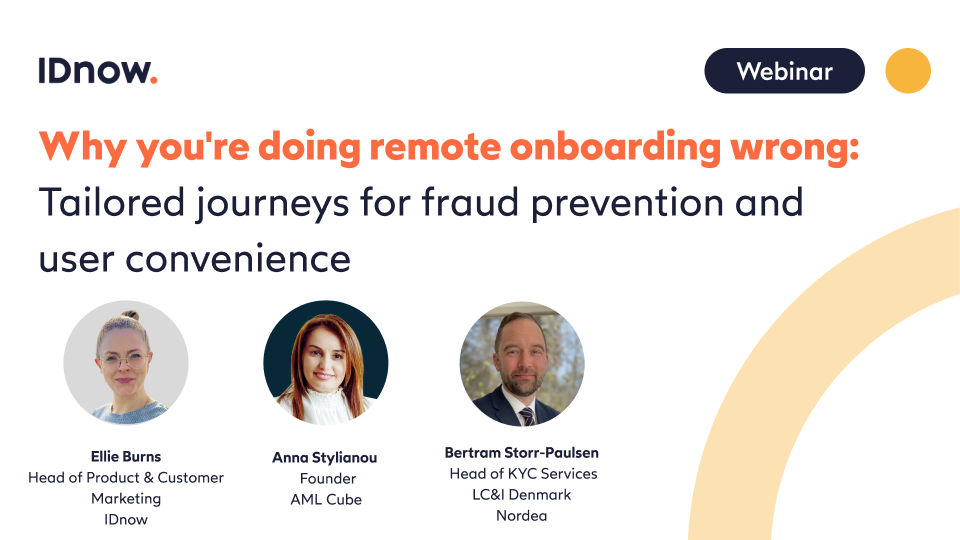A simple compliance requirement that needs to be completed asap or the most important part of the customer journey? Industry experts have their say.
The customer onboarding stage is arguably the most important touch point between a bank and its customer. Unfortunately, it’s also the part that a lot of banks are doing wrong, which can lead to compliance fines, fraud attacks and loss of reputation and revenue.
To discuss how to create an optimal onboarding experience that can both fight fraud and improve user experience, we partnered with Transform Finance to organize the ‘Why you’re doing remote onboarding wrong’ webinar.
Moderated by our very own Head of Product Marketing and Customer Communications, Ellie Burns, the webinar featured insights from Anna Stylianou, Founder of AML Cube and Bertram Storr-Paulsen, Head of KYC Services LC&I Denmark, Nordea.
Now available on-demand, the hour-long webinar covers a variety of topics, from how to meet regulatory compliance requirements and secure your onboarding process to how to build a trustworthy and convenient user experience.
Missed the webinar? Here’s our five key takeaways!
Why you’re doing remote onboarding wrong

1. Relationships with regulators need to improve.
“We’re not even halfway there,” appeared to be the general feeling during the webinar. However, according to participants, there are signs that the relationship between banks and regulators is trending in the right direction.
For example, the Anti-Money Laundering Authority in Frankfurt (AMLA) is likely to make a significant impact, offering a more unilateral and consistent regulatory perspective. Having an open environment where banks can discuss what is failing; what is working well; and how learnings can be exchanged will only improve the relationship between banks and regulators regarding anti-money laundering and other fraud risks.
2. Change is inevitable. Is your culture ready to adapt accordingly?
As one of the biggest challenges of entering new markets is complying with different regulations and requirements, banks need to have a culture that is willing to innovate quickly and adapt accordingly.
Onboarding customers the old way – via traditional Know Your Customer (KYC) processes like photocopying and stamping documents – is no longer acceptable; banks need to embrace new identity verification methods and onboarding procedures to fight fraud and cut costs in the modern age.
For some reason, in financial services, compliance and fraud are always treated separately, with separate teams etc, but they’re actually inextricably linked, especially during the onboarding stage.
Head of Product Marketing and Customer Communications, Ellie Burns
“So, how can banks ensure compliance teams and fraud teams are collaborating to make processes and onboarding flows as secure, trusted and seamless as possible for the customer?” asked Ellie.
3. The importance of balancing fraud and compliance.
Balancing effective fraud prevention with an onboarding process that works for all, regardless of risk level, is no easy task. The reality is that some customers are just not tech savvy or literate enough to use certain solutions, so banks need to be prepared to still ‘handhold’ the more vulnerable customers and offer more traditional onboarding options too.
However, it’s also important to remember that when doing so, banks need to be prepared for the repercussions of these ‘old-fashioned’ approaches, such as increased fraud.
Communication is key, especially between different departments with different goals. However, despite appearances, there are many common goals that should demand alignment between compliance teams and fraud teams. As such, these departments need to work together to find solutions that are both compliant and prevent fraud. It should never be an either/ or.
4. Technology has a major part to play. But so too do humans!
There is no such thing as the ‘perfect onboarding solution’, not only due to different regulatory requirements but also customer preferences. Even across the European region there are different approaches to customer onboarding. For example, in the UK there are data checks and document checks, while in Germany, there is video verification and of course eID. It’s also worth bearing in mind that as people tend to be multi-bankers, they’re often faced with multiple ‘perfect solutions’ following different standards and steps. Plus, of course, what is perfect for one person may not be for another.
While a lot of solutions focus on things like multi-factor authentication to make onboarding smoother, faster and more automated, there are other solutions that use live facial detection, which requires in-person assistance and face-to-face interaction.
Webinar participants agreed that there is still a danger in relying too heavily on fully automated processes as artificial intelligence is still not to be 100% trusted yet, especially with social engineering like APP scams. The value that video verification can provide should not be underestimated.
5. Is fraud prevention just a game of Whac-A-Mole?
Of course, the aim of banks is to stop fraud dead in its tracks – but the reality is that fraud is a constant, never-ending game of cat and mouse, with fraudsters evolving and developing ever-sophisticated attacks to penetrate defenses and vulnerabilities. So, if the banks can’t stop 100% of fraud, then the aim of the game is to make it as difficult as possible
So, how exactly can banks make it difficult for fraudsters? As bad actors often work around the clock using increasingly sophisticated fraud attacks, it can be difficult for banks to fight back. As such, there needs to be a more connected approach where banks are incentivized and feel willing to share information and learnings with one another. A multi-layered approach to fraud prevention is necessary as fraudsters work in a similar way!
Check out other webinar wrap-ups, like ‘5 takeaways from the ‘Sign of the times: The digital signature revolution’ webinar.’
By

Jody Houton
Senior Content Manager at IDnow
Connect with Jody on LinkedIn



